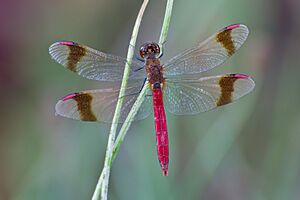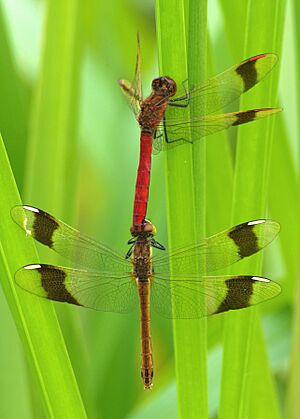Banded darter (dragonfly) facts for kids
Quick facts for kids Banded darter (dragonfly) |
|
|---|---|
 |
|
| Conservation status | |
| Scientific classification | |
| Genus: |
Sympetrum
|
| Species: |
pedemontanum
|
The banded darter (scientific name: Sympetrum pedemontanum) is a small, colorful dragonfly. It gets its name from the cool dark bands on its wings. You can often spot them by their bright red or yellow bodies. These dragonflies love to live near calm water, like ponds or slow-moving streams, especially where there isn't too much tall grass.
Contents
Where Do Banded Darters Live?
Banded darters are found all across Europe and Asia. They are quite adaptable and can even live in places changed by humans. You might find them in places like irrigated hay fields, marshy areas, or even rice paddies. They prefer banks with shorter grass, as this is where they like to lay their eggs. They lay their eggs in shallow water that is still or moves very slowly. Interestingly, dragonflies in the Sympetrum family can see special light reflections that help them find water.
Life Cycle of a Banded Darter
Banded darters have an interesting life cycle. Male and female dragonflies pair up, and the males often guard the females. The female dips her tail into the water to lay her eggs. These eggs are usually laid in the summer.
Dragonfly eggs can take a long time to hatch, sometimes from 80 to 230 days! They often spend the winter as eggs. The tiny dragonfly larvae (also called nymphs) hatch out the following summer. These larvae grow and change in the water. Adult banded darters usually appear in the summer. You can often see them flying around from mid-July until late October in Europe.
What Do Banded Darters Look Like?
Banded darters are smaller than many other dragonflies. They are usually less than 40 millimeters (about 1.5 inches) long. Their most special feature is the dark bands on their wings, which is how they got their name. The bands on their back wings are usually a bit wider than those on their front wings.
The color of these bands can change a little depending on the dragonfly's age and where it lives. For example, dragonflies in the west might have wider bands, and those in the north might have brighter ones. As a banded darter gets older, its wing bands often become darker.
Their body color also changes with age. Young banded darters might be yellow. As males get older, their bodies turn bright red. Females usually stay yellowish. Like most dragonflies, banded darters are active during the day. They have amazing compound eyes that help them see colors and details very well.
Look for these key features:
- Males have a red body, while females are yellow.
- They have black marks on their body and legs.
- Their wings have clear, dark bands.
Sometimes, young female banded darters might look a bit like another dragonfly called Orthetrum anceps because of their yellow color. However, you can tell them apart because Orthetrum anceps has special stripes on its body that banded darters don't have.
What Do Banded Darters Eat?
Dragonflies are expert hunters, and the banded darter is no different! They are fierce predators that catch their food while flying. They often attack from below, using their excellent eyesight to spot and catch their prey. Adult banded darters eat many kinds of small insects.
When they are young larvae living in the water, they are also predators. They eat many small creatures that live in ponds. Their diet can include tiny tadpoles, mosquito larvae, mayfly larvae, and small crustaceans (like tiny shrimp).
Banded Darter Family Tree
The banded darter belongs to the Sympetrum group of dragonflies. This group includes a few other similar species like Sympetrum intermedium, Sympetrum kurentzovi, and Sympetrum elatum. It can sometimes be tricky for scientists to decide exactly which species belong in this group because they share many features. One common feature among Sympetrum dragonflies is a special part of their body called a prothorax that has long hairs. However, other dragonflies also have this trait.



